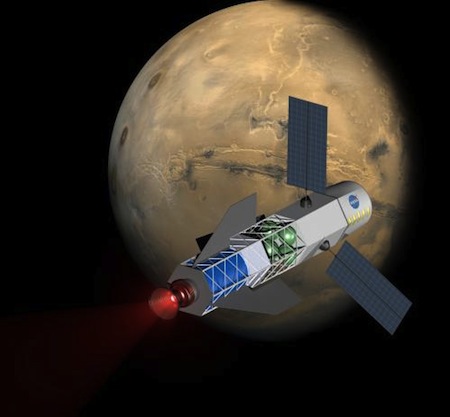Science Fiction
Dictionary
A B C D E F G H I J K L M N O P Q R S T U V W X Y Z
30-Day Trip To Mars?

In his 1961 novel Stranger in a Strange Land, Robert Heinlein is clear about the real-world limitations of space travel to Mars with minimum energy paths:
After making the trip the old fashioned way, a new technology becomes available:
This week, University of Washington researchers and scientists announced their progress in building components of a fusion-powered rocket that could drop the long months required for such a trip to mere weeks.
At that time, only eight Terran years after the founding of the first human colony on Luna, any interplanetary trip made by humans necessarily had to be made in weary free-fail orbits, doubly tangent semi-ellipses--from Terra to Mars, two hundred fifty-eight days, the same for the return journey, plus four hundred fifty-five days waiting at Mars while the two planets crawled slowly back into relative positions which would permit shaping the doubly-tangent orbit-a total of almost three Earth years.
The Federation Ship Champion, manned by an all-male crew of eighteen experienced spacemen and carrying more than that number of male pioneers, made the crossing under Lyle Drive in only nineteen days. The Champion landed just south of Lacus Soli, as Captain van Tromp intended to search for the Envoy.

(A concept image of a spacecraft powered by a fusion-driven rocket)
"Using existing rocket fuels, it's nearly impossible for humans to explore much beyond Earth," said lead researcher John Slough, a UW research associate professor of aeronautics and astronautics. "We are hoping to give us a much more powerful source of energy in space that could eventually lead to making interplanetary travel commonplace."Slough and his team have published papers calculating the potential for 30- and 90-day expeditions to Mars using a rocket powered by fusion, which would make the trip more practical and less costly.
Slough and his colleagues at MSNW think so. They have demonstrated successful lab tests of all portions of the process. Now, the key will be combining each isolated test into a final experiment that produces fusion using this technology, Slough said.
(The Fusion Driven Rocket: Animation)
The Fusion Driven Rocket
Thin hoops of metal are driven at the proper angle and speed for convergence onto target plasmoid at thruster throat. A target Deuterium FRC plasmoid is created and injected into thruster chamber.
Target FRC is confined by axial magnetic field from shell driver coils as it translates through chamber eventually stagnating at the thruster throat.
Converging shell segments form fusion blanket compressing target FRC plasmoid to fusion conditions. The shell absorbs neutrons emitted during fusion.
Vaporized and ionized by fusion neutrons and alphas, the plasma blanket expands against the divergent magnetic field resulting directed flow of the metal plasma out of the magnetic nozzle.
Via Physorg.
Scroll down for more stories in the same category. (Story submitted 4/7/2013)
Follow this kind of news @Technovelgy.| Email | RSS | Blog It | Stumble | del.icio.us | Digg | Reddit |
Would
you like to contribute a story tip?
It's easy:
Get the URL of the story, and the related sf author, and add
it here.
Comment/Join discussion ( 0 )
Related News Stories - (" Space Tech ")
Will Space Stations Have Large Interior Spaces Again?
'They filed clumsily into the battleroom, like children in a swimming pool for the first time, clinging to the handholds along the side.' - Orson Scott Card, 1985.
Reflect Orbital Offers 'Sunlight on Demand' And Light Pollution
'I don't have to tell you about the seven two-mile-diameter orbital mirrors...'
Chrysalis Generation Ship to Alpha Centauri
'This was their world, their planet —
this swift-traveling, yet seemingly moveless vessel.' - Nat Schachner, 1934
The First Space Warship For Space Force
'Each of the electrical ships carried about twenty men...' - Garrett P. Serviss, 1898.
Technovelgy (that's tech-novel-gee!) is devoted to the creative science inventions and ideas of sf authors. Look for the Invention Category that interests you, the Glossary, the Invention Timeline, or see what's New.
Science Fiction
Timeline
1600-1899
1900-1939
1940's 1950's
1960's 1970's
1980's 1990's
2000's 2010's
Current News
BrainBridge Actual Transplant Of Human Head Proposed
'Briquet’s head seemed to think that to find and attach a new body to her head was as easy as to fit and sew a new dress.'
Google's Nano Banana Pro Presents Handwritten Math Solutions
'...copy was turned out in a charming and entirely feminine handwriting.'
Edible Meat-Like Fungus Like Barbara Hambly's Slunch?
'It was almost unheard of for slunch to spread that fast...'
Sunday Robotics 'Memo
'He then started hand movements of definite pattern...'
Woman Marries Computer, Vonnegut's Dream Comes True
'Men are made of protoplasm... Lasts forever.'
Natural Gait With Prosthetic Connected To Nervous System
'The leg was to function, in a way, as a servo-mechanism operated by Larry’s brain...'
Spidery 'Walk Me' Toyota Autonomous Wheel Chair Like Star Wars
Walk along with the emperor.
Dancing Robots Taught Dance Moves
'A clockwork figure would be the thing for you...'
Proof Of Robothood - Not A Person
'Who are you people? - Show 'em.'
Indonesian Clans Battle
'The observation vehicle was of that peculiar variety used in conveying a large number of people across rough terrain.'
The 'Last Mile' In China Crowded With Delivery Robots
Yes, it's a delivery robot. On wheels.
Tornyol Microdrone Kills Mosquitoes
'The real border was defended by... a swarm of quasi-independent aerostats.'
PLATO Spacecraft, Hunter Of Habitable Planets, Now Ready
'I ... set my automatic astronomical instruments to searching for a habitable planet.'
Factory Humanoid Robots Built By Humanoid Robots
'...haven't you a section of the factory where only robot labor is employed?'
iPhone Air Fulfils Jobs' Promise From 2007 - A Giant Screen!
'... oblongs were all over the floor and surfaces.'
ChatGPT Now Participates in Group Chats
'...the city was their laboratory in human psychology.'
